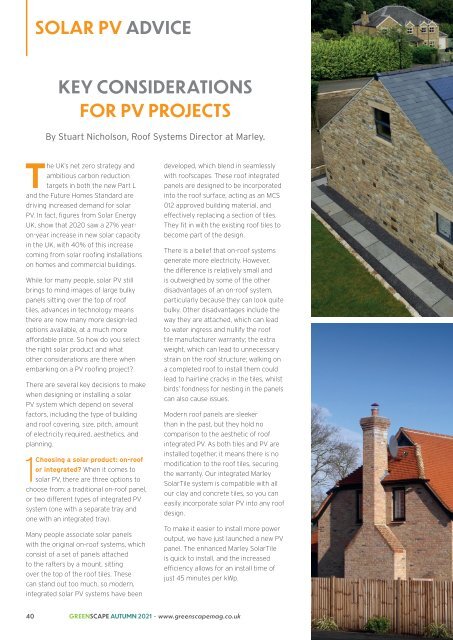Autumn '21
You also want an ePaper? Increase the reach of your titles
YUMPU automatically turns print PDFs into web optimized ePapers that Google loves.
SOLAR PV ADVICE<br />
KEY CONSIDERATIONS<br />
FOR PV PROJECTS<br />
By Stuart Nicholson, Roof Systems Director at Marley.<br />
The UK’s net zero strategy and<br />
ambitious carbon reduction<br />
targets in both the new Part L<br />
and the Future Homes Standard are<br />
driving increased demand for solar<br />
PV. In fact, figures from Solar Energy<br />
UK, show that 2020 saw a 27% yearon-year<br />
increase in new solar capacity<br />
in the UK, with 40% of this increase<br />
coming from solar roofing installations<br />
on homes and commercial buildings.<br />
While for many people, solar PV still<br />
brings to mind images of large bulky<br />
panels sitting over the top of roof<br />
tiles, advances in technology means<br />
there are now many more design-led<br />
options available, at a much more<br />
affordable price. So how do you select<br />
the right solar product and what<br />
other considerations are there when<br />
embarking on a PV roofing project?<br />
There are several key decisions to make<br />
when designing or installing a solar<br />
PV system which depend on several<br />
factors, including the type of building<br />
and roof covering, size, pitch, amount<br />
of electricity required, aesthetics, and<br />
planning.<br />
1Choosing a solar product: on-roof<br />
or integrated? When it comes to<br />
solar PV, there are three options to<br />
choose from: a traditional on-roof panel,<br />
or two different types of integrated PV<br />
system (one with a separate tray and<br />
one with an integrated tray).<br />
Many people associate solar panels<br />
with the original on-roof systems, which<br />
consist of a set of panels attached<br />
to the rafters by a mount, sitting<br />
over the top of the roof tiles. These<br />
can stand out too much, so modern,<br />
integrated solar PV systems have been<br />
developed, which blend in seamlessly<br />
with roofscapes. These roof integrated<br />
panels are designed to be incorporated<br />
into the roof surface, acting as an MCS<br />
012 approved building material, and<br />
effectively replacing a section of tiles.<br />
They fit in with the existing roof tiles to<br />
become part of the design.<br />
There is a belief that on-roof systems<br />
generate more electricity. However,<br />
the difference is relatively small and<br />
is outweighed by some of the other<br />
disadvantages of an on-roof system,<br />
particularly because they can look quite<br />
bulky. Other disadvantages include the<br />
way they are attached, which can lead<br />
to water ingress and nullify the roof<br />
tile manufacturer warranty; the extra<br />
weight, which can lead to unnecessary<br />
strain on the roof structure; walking on<br />
a completed roof to install them could<br />
lead to hairline cracks in the tiles, whilst<br />
birds’ fondness for nesting in the panels<br />
can also cause issues.<br />
Modern roof panels are sleeker<br />
than in the past, but they hold no<br />
comparison to the aesthetic of roof<br />
integrated PV. As both tiles and PV are<br />
installed together, it means there is no<br />
modification to the roof tiles, securing<br />
the warranty. Our integrated Marley<br />
SolarTile system is compatible with all<br />
our clay and concrete tiles, so you can<br />
easily incorporate solar PV into any roof<br />
design.<br />
To make it easier to install more power<br />
output, we have just launched a new PV<br />
panel. The enhanced Marley SolarTile<br />
is quick to install, and the increased<br />
efficiency allows for an install time of<br />
just 45 minutes per kWp.<br />
40 GREENSCAPE AUTUMN 2021 • www.greenscapemag.co.uk

















